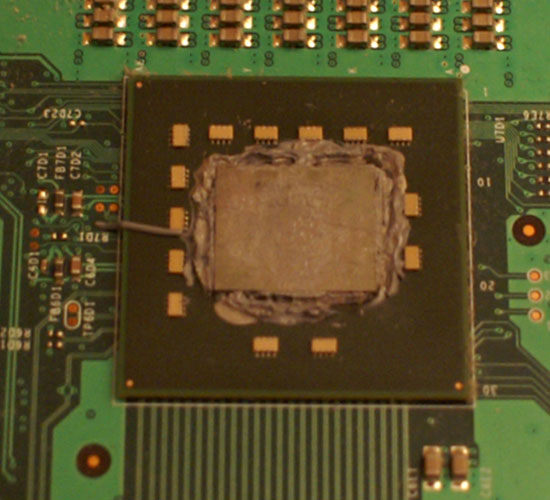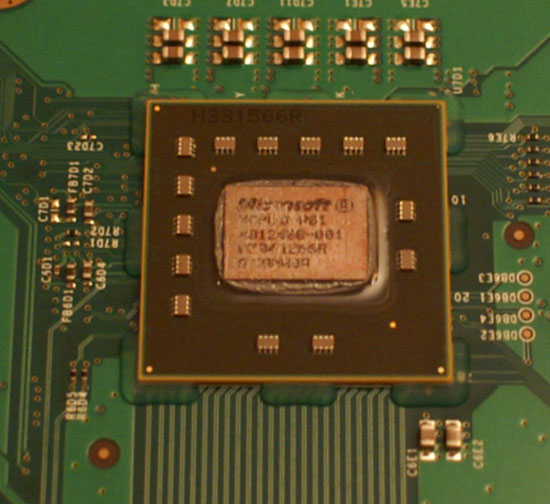Microsoft's Xbox 360 goes 65nm: Falcon Dissection and Power Consumption
by Anand Lal Shimpi on November 15, 2007 11:55 PM EST- Posted in
- Smartphones
- Mobile
The New Chips
Microsoft never released die sizes for the Xbox's chips so we had to break out the trusty ruler and measure both the old and new chips, to get an idea of how things have changed. The table below shows our findings:
| Chip | Old Die Size | New Die Size | % of Old Die |
| CPU | 176 mm^2 | 133 mm ^2 | 75.5% |
| GPU | 182 mm^2 | 156 mm^2 | 85.7% |
| eDRAM | 80 mm^2 | 68 mm^2 | 85% |
Here's what's interesting: the CPU, GPU and eDRAM die all seem to have gotten smaller, but at different rates. The CPU sees the biggest reduction in size, the new core being about 75% the size of the old one, while both GPU components are around 85% the size of their predecessors.

The old CPU

The new CPU

The old GPU

The new GPU
It's possible that all three chips are now 65nm, or a mixture of 65nm and 80nm (TSMC's 80nm half-node process was used in ATI's R600 GPU). Needless to say, the chips are all smaller, which should yield some nice power savings.










46 Comments
View All Comments
ChristopherO - Sunday, November 18, 2007 - link
It looked like you were familiar, but I partly mentioned that because other people reading might not have been. You never know when you can win over a convert.That's funny you have a Seasonic... We're probably running the same PSU, I have the S12 600, which I got for a steal when Silicon Acoustics went out of business. 2.5" drives are a great way to go, but I'm not willing to give up the performance of a Raptor for one. My Raptor 150 in suspension is near silent. I'm on Vista 64, with 4GB memory, so that helps the seek situation... Vista caches everything it can at boot time, so once you're through the initial power-on phase, everything is pretty sedate.
Sure you can cap the DVD reads, but I use a dense foam padding that I use in lieu of the Sonata rails in my chassis and the net effect is that the drive is vastly quieter. It is the nosiest component of the system, but that doesn't bug me because hardly anything uses discs these days. Typically you install, and then you're done. Or you insert a game and run the "piracy check" and then the drive spins down. Inserting a movie, etc, doesn't spin the drive up so that's not even audible.
AssBall - Saturday, November 17, 2007 - link
I took my DVD ROM out of my case and, quite frankly, it is significatly louder in my hand than it was when being muffled by the case (no rubber washers).saiku - Friday, November 16, 2007 - link
is there something that would wrap around the hd-dvd drive? would still have to leave the vent holes open but perhaps some material out there that damps noise?ChristopherO - Friday, November 16, 2007 - link
I haven't seen the inside of the HD DVD add-on. Generally speaking you'd want to remove the drive and dampen that (perhaps building a custom chassis). Otherwise the HD DVD add-on will have metal to metal contact and thus be generating noise that you can't isolate. Wrapping the whole thing in foam isn't very practical.swaaye - Friday, November 16, 2007 - link
It's the damn DVDROM. They have that thing cranking at full RPMs almost all of the time. Hell, I've heard the disk come out of its grip once and spin out inside. It's ridiculous, IMO.provoko - Friday, November 16, 2007 - link
Thanks for opening up a 360 for us and testing it. =) I enjoyed the wattage charts, the same ones you use for CPUs.semo - Friday, November 16, 2007 - link
what is a half-node?and
it still has hasn't it? when will the ps3 get a gpu shrink btw.
ChristopherO - Friday, November 16, 2007 - link
A half-node is basically a die shrink that doesn't require reworking the component.For instance you can't take a 90nm chip, and convert it to 65nm without redesigning the chip. Sure the end product would be substantially the same, but you will need to rework a considerable portion to fit the new size. 65nm to 45nm is the same, you need to redesign your chip.
The 80nm shrink lets you use the same design as 90nm, but smaller.
More than likely the GPU is an 80nm design.
For example, shrinking from 90 to 80 gives you 88.8% size (which is close to Anand's measured 85%). Shrinking from 90 to 65 is 72.2% the size, however this will be less exact than the half-node since the chip itself is going to be somewhat different (75% is a good enough estimate). Both these sizes will result in a decent heat and power savings.
No one can say if this will kill-off the RROD, but it stands a pretty good chance.
I'm willing to guess that the failure rates will drop to something normal (a single-digit percentage). No guarantee on that, but they trimmed off 70 watts of power usage, that's a pretty remarkable savings which will go a long way towards improving the overall heat situation. Not to mention that their GPU heat sinks are substantially beefier, so you're dissipating less heat over a larger area. Even if the GPU was the same, it will have less contention with the CPU for air cooling.
Too bad they didn't mount the DVD ROM on rubber grommets. It isn't bad when properly isolated, but the metal case is acting like an amplifier.
psychobriggsy - Sunday, November 18, 2007 - link
Um, 90nm to 80nm results in a theoretical die area of 79% of the 90nm one - remember there are two dimensions to the shrink.90nm to 65nm results in a die area of 52% of the 90nm one, ideally.
Scaling never achieves that due to factors such as the spacing between transistors not scaling as well, or the shrink not scaling well in one axis compared to the other, or a million other reasons. Hence I believe that the GPU is 80nm, and the CPU is 65nm.
The shrink indeed should reduce or halt the RROD situation if it was caused by excessive heat leading to warping that broke contacts.
ChristopherO - Monday, November 19, 2007 - link
Whoops, you were right. I typed fast and forgot to multiply the reduction by 2.In theory the 80nm shrink should scale more linearly since it is fundamentally similar to the 90nm part. The 65nm part has the potential to be significantly different. I guess the numbers bear that out, the GPU is much closer to predicted than the CPU.
It makes me wonder what else they might have changed. In theory they could have made alterations to the chip that increased media performance, etc, without impacting general computations and expected behavior within a game.
It's a weird quandary since they have a baseline level of performance which they aren't trying to diverge from.